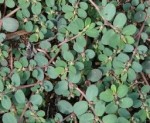 Looking at this pesky annual weed you would never know that it is in the same genus as pointsetta. A native of eastern United States, this warm weather weed has spread to all states except Alaska. It does well in sunny sites where soils are dry and low in nutrients and can be found in lawns, pavement cracks, driveways, roadsides and other waste areas as well as in gardens. During warm weather it can complete its life cycle in 5-6 weeks so it can produced two or more generations in a season.
Looking at this pesky annual weed you would never know that it is in the same genus as pointsetta. A native of eastern United States, this warm weather weed has spread to all states except Alaska. It does well in sunny sites where soils are dry and low in nutrients and can be found in lawns, pavement cracks, driveways, roadsides and other waste areas as well as in gardens. During warm weather it can complete its life cycle in 5-6 weeks so it can produced two or more generations in a season.
 Description: Seedlings emerge from early summer to early fall. The plants grow quickly and form a dense mat up to 2’ in diameter of slender pinkish-red sprawling stems radiating from a central tap root that may be 2’ long. The stems of prostrate spurge, like those of other Euphorbias, exudes a milky sap when cut or broken. This sap can be irritating to the skin. The small opposite leaves are elliptical and about 1/8” to ½” long and ½” wide. Inconspicuous pinkish-white flowers are produced at the tips of the stems are in leaf axils and are followed by hairy, three-seeded capsules. Each plant can produce several thousand seeds that remain in the soil over the winter and germinate in the spring when temperatures reach 60o F. or higher. Frost kills the plants.
Description: Seedlings emerge from early summer to early fall. The plants grow quickly and form a dense mat up to 2’ in diameter of slender pinkish-red sprawling stems radiating from a central tap root that may be 2’ long. The stems of prostrate spurge, like those of other Euphorbias, exudes a milky sap when cut or broken. This sap can be irritating to the skin. The small opposite leaves are elliptical and about 1/8” to ½” long and ½” wide. Inconspicuous pinkish-white flowers are produced at the tips of the stems are in leaf axils and are followed by hairy, three-seeded capsules. Each plant can produce several thousand seeds that remain in the soil over the winter and germinate in the spring when temperatures reach 60o F. or higher. Frost kills the plants.

 Control: Hand-pulling and hoeing are good methods of controlling prostrate spurge in most places. Mature plants have deep taproots, so hand pulling them can be challenging because new plants will grow if leaf buds remain behind in the soil. If prostrate spurge invades a lawn, improving the lawn through proper fertilization, watering and mowing will discourage the spurge because it can not compete favorably with the grass. A preemergent herbicide in spring is effective in reducing seed germination.
Control: Hand-pulling and hoeing are good methods of controlling prostrate spurge in most places. Mature plants have deep taproots, so hand pulling them can be challenging because new plants will grow if leaf buds remain behind in the soil. If prostrate spurge invades a lawn, improving the lawn through proper fertilization, watering and mowing will discourage the spurge because it can not compete favorably with the grass. A preemergent herbicide in spring is effective in reducing seed germination.